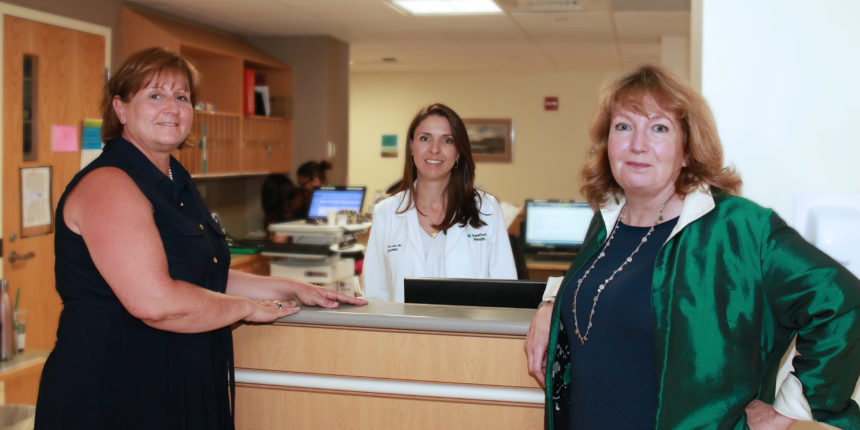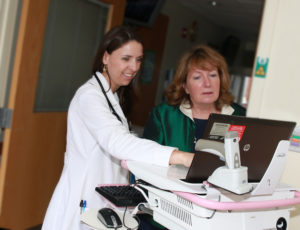News Releases
Southcoast Health marks a decade of Hospitalist Program

Tobey, St. Luke’s and Charlton Memorial mark 10 years of a new way to treat patients
NEW BEDFORD, Mass. — In 2007, Southcoast Health embarked on a new way to provide inpatient care, becoming a pioneer in implementing a Hospitalist Program model that has dramatically changed the way patients and family experience a hospital stay.
“There are still some patients who have never heard of a hospitalist and tend to have questions,” said Patricia Mangan-Ball, Patient-Hospitalist Ambassador at Southcoast Health. “They remember the old days when the doctor arrived early in the morning to visit on rounds, then returned to his or her office. We explain that now with the Hospitalist Program the doctor is there all day, that they don’t leave and they’re always available.”
Today, St. Luke’s Hospital in New Bedford, Charlton Memorial Hospital in Fall River and Tobey Hospital in Wareham are staffed by more than 60 hospitalists who are board certified in Internal Medicine or Family Practice. Southcoast Health Medicine Care Center Executive Director Kelly Roderick said the use of hospitalists is a way of caring for patients that has gone from rare and sometimes controversial a decade ago, to an accepted best-practice at larger hospitals across the country.

Each day, Southcoast Health hospitalists provide medical care to 300 patients across the three campuses. That care is 24 hours a day, seven days a week.
“Our team provides continuous in-house coverage, which has made a significant difference in the level of service we provide,” Roderick said. “It is patient-focused care, which ultimately improves both the patient experience and clinical outcomes.”
When Southcoast Health began its Hospitalist Program, there were approximately 1,000 hospitalists nationwide. Now, that number is approaching 44,000, according to the Society of Hospital Medicine. In fact, the American Association of Medical Colleges says the specialty is one of the fastest growing in American medical schools. In a recent publication, the United States Department of Labor noted the key attributes of doctors in the hospitalist role are sound decision-making, excellent communication skills, and a sympathetic bedside manner.
“Initially, we didn’t know if the concept would work,” Roderick said. “Fortunately, we had primary care physicians in our community who were early adopters and willing to partner with us. They found it increasingly challenging to come to the hospital every morning, then going to their office to see a full schedule of patients.”
Technological developments – especially the adoption of the Epic electronic medical records system – have allowed hospitalists and primary care physicians to stay in constant contact about the conditions, treatments and prescriptions for patients.
And the availability of a physician in the hospital 24/7 means families have a chance to talk with doctors about patients throughout the day and week.
“When families come to the hospital I try to communicate with them on a daily basis,” said Dr. Ana Laus, a Southcoast Health hospitalist for the last six years. “I introduce myself, give them my card and my contact information, and I ask that I be allowed to contact them. When they come to the hospital, they can page me and I’m there. And for some who live far away – a daughter in Florida or a son in New Hampshire for example – I can call them with updates on their mother on a daily basis and keep them in touch.”
Patient Ambassador Mangan-Ball agrees that most patients feel the round-the-clock medical care is crucial – but so is the regular family contact.
“The daughter of an elderly patient was sitting on the bed in the room and thought that the doctor had already been in and she had missed him,” said Mangan-Ball. “I told her it was not like the old days, that he was here, and that I could page him. She was thrilled. When I went back to the room they were talking and I think it was a great relief.”
Dr. Laus said increasingly physicians deciding on a specialty are drawn to becoming hospitalists.
“What attracted me was the ability to care for patients holistically,” Dr. Laus said. “We are providing care for their acute needs when they need us the most – when they are sick, or recovering, and are vulnerable. I can see them immediately, contact the family immediately, and communicate daily with the nurses, pharmacists and specialists.”
And Dr. Laus said despite long hours – 12 hour days for seven days straight, then seven days off – doctors thrive on the environment.
“I like the setting – I like the fast pace of a hospital,” she said.
According to a study by Medicare, hospitalists are succeeding in the most important area of all: A wide-ranging 2012 study that hospitals with hospitalists on board had higher patient satisfaction than those without.
